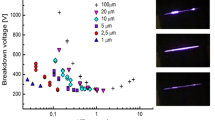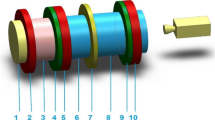Abstract
A plasma device with large diameter and short interelectrode distance has been designed and implemented. Theoretical modeling and simulations have been carried out for different interelectrode distances, and experimental results obtained under different pressures p, both with argon atmosphere. The device produces direct-current (dc) discharges in the parallel-plate electrode configuration, with gallium phosphide (GaP) semiconductor at one side and SnO2-coated glass conducting material at the other side, separated by gas medium with width of 50 μm to 500 μm. The device can be operated under different values of interelectrode distance d, applied voltage U, and gas pressure p. Current–voltage characteristics and breakdown voltages have been found experimentally and theoretically. In addition, theoretical breakdown curves have been derived from simulations. The theory can also identify the space-charge density, thermal electron velocity, reduced electric field strength (E/N), electron density ne, and secondary-electron emission (γ). Comparison between experiment and theory shows that the theory can estimate the breakdown very well for low pressure and small interelectrode gap.
Similar content being viewed by others
References
H.W. Seo, S.Y. Bae, J. Park, H. Yang, M. Kang, S. Kim, J.C. Park, and S.Y. Lee, Appl. Phys. Lett 82, 3752 (2003).
I. Fuss and D. Smart, Appl. Opt. 30, 4526 (1991).
Z.G. Chen, L. Cheng, G.Q.M. Lu, and J. Zou, Nanotechnology 21, 375701 (2010).
Q. Wu and X. Zhang, Appl. Phys. Lett. 70, 1784 (1997).
F. Liu, Y.J. Song, Q.R. Xing, M.L. Hu, Y.F. Li, C.L. Wang, L. Chai, W.L. Zhang, A.M. Zheltikov, and C.Y. Wang, IEEE Photon. Technol. Lett. 22, 814 (2010).
D. McIntosh, Q.G. Zhou, F.J. Lara, J. Landers, and J.C. Campbell, IEEE Photon. Technol. Lett. 23, 878 (2011).
Yu.P. Raizer, Gas Discharge Physics (Berlin: Springer, 1991), p. 449.
H. Luo, Z. Liang, B. Lv, X. Wang, Z. Guan, and L. Wang, Appl. Phys. Lett. 91, 221504 (2007).
H. Yucel Kurt, E. Kurt, and B.G. Salamov, Cryst. Res. Technol. 39, 743 (2004).
M.S. Mokrov and Yu.P. Raizer, Plasma Sources Sci. Technol. 17, 035031 (2008).
Yu.B. Golubovskii, V.A. Maiorov, P. Li, and M. Lindmayer, J. Phys. D 39, 1574 (2006).
N. Gherardi, E. Croquesel, N. Naude, P. Veis, and F. Massines, Proceedings of the 8th International Symposium on High Pressure Low Temperature Plasma Chemistry (HAKONE VIII) (Puhajarve, Estonia, 2002).
E. Kurt, H. Kurt, and U. Bayhan, Cent. Eur. J. Phys. 7, 123 (2009).
H. Kurt, S. Cetin, and B.G. Salamov, IEEE Trans. Plasma Sci. 39, 1086 (2011).
O. Noblanc, C. Arnodo, C. Dua, E. Chartier, and C. Brylinski, Mater. Sci. Forum 338, 1247 (2000).
V.V. Buniatyan and V.M. Aroutiounian, J. Phys. D (2007). doi:10.1088/0022-3727/40/20/S18.
Yu.A. Astrov, A.N. Lodygin, and L.M. Portsel, Phys. Rev. E 91, 032909 (2015).
L. Schwaederle, M.K. Kulsreshath, L.J. Overzet, P. Lefaucheux, T. Tillocher, and R. Dussart, J. Phys. D 45, 065201 (2012).
M. Klas, S. Matejcik, B. Radjenovic, and M.R. Radjenovic, Phys. Scr. 83, 045503 (2011).
T.G. Rogers, A.A. Neuber, K. Frank, G.R. Laity, and J.C. Dickens, IEEE Trans. Plasma Sci. 38, 2764 (2010).
A.V. Phelps and Z.Lj. Petrovic, Plasma Sources Sci. Technol. 8, R21 (1999).
L.E. Kline and J.G. Siambis, Phys. Rev. A 5, 794 (1972).
M. Kaku, Y. Sato, and S. Kubodera, Appl. Phys. B 107, 85 (2012).
L. Schwaederlé, M.K. Kulsreshath, L.J. Overzet, P. Lefaucheux, T. Tillocher, and R. Dussart, J. Phys. D 45, 065201 (2012).
C.H. Chen, J.A. Yeh, and P.J. Wang, J. Micromech. Microeng. 16, 1366 (2006).
D. Mariotti, J.A. McLaughlin, and P. Maguire, Plasma Sources Sci. Technol. 13, 207 (2004).
H.B. Smith, C. Charles, and R.W. Boswell, Phys. Plasmas 10, 875 (2003).
Z.Lj. Petrovic, N. Skoro, D. Maric, C.M.O. Mahony, P.D. Maguire, M.R. Radenovic, and G. Malovic, J. Phys. D 41, 194002 (2008).
V.I. Gibalov and G.J. Pietsch, Plasma Sources Sci. Technol. 21, 024010 (2012).
M. Krüger, M. Schenk, M. Förster, and P. Hommelhoff, J. Phys. B 45, 074006 (2012).
M.M. Nudnova and A.Yu. Starikovskii, J. Phys. D 41, 234003 (2008).
B.G. Salamov, J. Phys. D 37, 2496 (2004).
G.G. Raju, Gaseous Electronics (Boca Raton: Taylor & Francis, 2006), p. 93.
H.Y. Kurt and E. Kurt, Elektronika ir Elektrotechnika 20, 1392 (2014).
B.G. Salamov, J. Phys. D 37, 2496 (2004).
E. Koc, S. Karaköse, and B.G. Salamov, Phys. Status Solidi A 210, 1806 (2013).
Acknowledgements
This research was funded by Grants BAP Nos. 05/2012-47 and 05/2012-72 from the Gazi University Scientific Research Project Unit.
Author information
Authors and Affiliations
Corresponding author
Rights and permissions
About this article
Cite this article
Kurt, H.H., Tanrıverdi, E. & Kurt, E. Theoretical and Experimental Exploration of Breakdown Phenomena in an Argon-Filled GaP Device. J. Electron. Mater. 45, 3970–3977 (2016). https://doi.org/10.1007/s11664-016-4539-9
Received:
Accepted:
Published:
Issue Date:
DOI: https://doi.org/10.1007/s11664-016-4539-9




